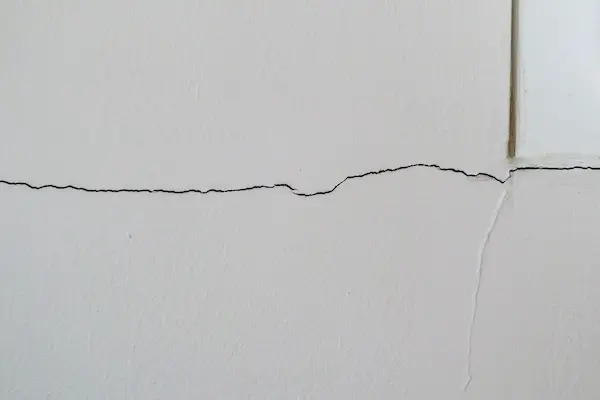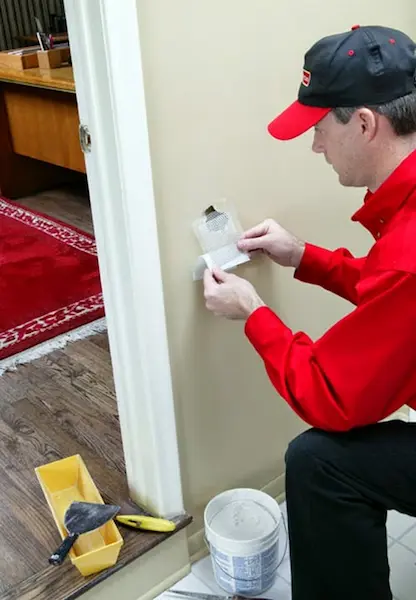A Homeowner’s Guide: Why Does A Drywall Crack Keep Coming Back?

If you’ve noticed a crack snaking through your drywall or ceiling, it’s a cause for concern. Drywall cracks usually emerge due to your home’s foundation being compromised either by its natural settlement, foundation swaying, fluctuations in humidity temperature levels based on local climate, and seismic activity, which all put an immense amount of concentrated stress on the drywall’s materials. Although minor cracks here and there along the edges of your walls and ceilings are just a part of the natural process of your home settling into its base foundation overtime, noticeably larger cracks and fractures bigger than 1/8 inch wide smack dab in the middle of a room is a red flag as this is a serious sign of structural damage.
Although there is not an exact target calculation that decides if a crack is problematic, mostly a large, jagged, and diagonal crack does indicate your home has a serious structural problem, as the foundation it sits atop may be shifted, sunk, or has some other issue such as the collapse of any surrounding wooden structures or damage from a termite infestation. For example, if you see a wall crack run vertically across the ceiling and down the length of the wall or a horizontal crack that goes across the wall itself, you have a problem.
Although it’s difficult to determine the exact depth of the drywall crack by just eyeballing it, it’s best to ask a professional carpenter to determine if it’s shallow or deep in nature and its root cause. Despite a drywall crack being due to foundation damage and movement and the result of the accumulation of moisture behind the crack–not all cracks have the same level of girth. So it may be about time to ask a certified, licensed, and fully insured Wichita handyman from Mr. Handyman of Wichita Metro East to diagnose and inspect the crack for a drywall repair.
What Is Drywall And Why Is It Essential?
Drywall is a construction material made of plaster, wood pulp, and other materials used to assemble and line walls and ceilings. It is highly durable and provides an extra layer of protection between rooms in your living space and the great outdoors. It also serves as a sound muffler for noise pollution and can be further encased with insulation to boost your home’s energy efficiency and livability. It’s a more studier material compared to its counterparts of wood and plaster, as drywall is made of a softer material known as gypsum, which doesn’t crack as easily and works best for finishing the interior of a house.
Here are just some of the numerous benefits of drywall:
- High durability
- Can be painted over
- Easy to install
- Doesn’t require sanding to be finished
- Drywall surface is easier to repair for damage
- Fire-resistant
- Sound muffler
- Insulator for fluctuating temperatures
- Less upfront expensive for installation
- Energy efficient
What Are The Reasons For Drywall Damage?

Drywall is a resilient material, but of course, it’s not indestructible and is bound to fall into disrepair over the years as it’s not completely foolproof and resistant to physical impact. Eventually, you will notice hairline cracks or fractures, small holes, damaged corners, peeling tapes, and joints cracking up. However, a drywall crack will keep coming back until you address the root cause of the underlying foundation damage, whether it’s a damaged concrete slab or soil erosion around the foundation. But as far as temporary and cosmetic quick-fixes go, it’s best to hire an expert technician for drywall repair the surface-level damage with a fresh coat of paint or tube of caulk at the very least.
Leakages From Water And Moisture Damage
If your concrete slab is impaired in any way whatsoever, it will result in a leakage, resulting in damage to flooring surfaces. But if the slab leak were to swell, it could damage certain spots of your foundation or even move it. A slab leak is a leak in a pipe beneath the foundation of your home. As the soil around the pipe expands and contracts, it forces your home’s foundation to crack, sway, shift, and sink. If the pipe has completely ruptured, you will require a plumber to perform a trenchless pipe repair or replacement service. And so the drywall crack on your wall may be due to an unresolved slab leak, which will only get worse unless fixed.
On the other hand, what goes up must come down. That is, although the most likely culprit for a persistent drywall crack on your ceiling could be damage to your home’s foundation, it could also be due to a burst pipe from the bathroom’s toilet above or a leaky roof. Your home is an intricately connected and multifaceted system, so if one thing is broken, it will cause a ripple effect of further problems. For example, if your home does not have a rain gutter installed, it can result in water and moisture damage to your soffits, fascia boards, and siding of your roofline, which eventually floods out your attic. Finally, the extra water from a leaky roof will result in a damaged ceiling.
Termites
As small but mighty pests, termites can surprisingly wreak havoc as they leech off of other materials apart from wood. Anything that contains cellulose termites will infest as termites can create teeny pinholes to exit into and out of walls and expand their colonies. If you’ve noticed tiny pinholes in your drywall, you are likely dealing with a termite infestation.
Rodents
Furry pests like mice can tunnel through your foundation and walls, and although you can hire an extermination company to get rid of them, you still require drywall replacement. For future reference, your best bet is to seal cracks in your foundation and walls early on and avoid using plastic, rubber, or wood to plug them up as mice grow and chew through these materials. It’s also a good idea to have a clean house and trim extra shrubbery so the mice don’t have an excuse for a cozy hideout.
Popped Nails
A popped nail is due to the expansion and contraction of the wood frame behind the drywall. Generally, homes are upheld by a wood framing that attaches to the drywall. But as the seasons change and the local climate changes too with fluctuating temperatures, the wood framing, in turn, enlarges and shrinks based on the humidity. And so, the wood becomes frail and loses its tight grip on the nail or screw. It’s best not to outrightly ignore these popped nails as they can be a part of the drywall stud, which you can remove using a pair of pliers.
Foundation Settling
As mentioned above, cracks in walls or ceilings are normal sometimes as they indicate your home’s foundation is settling, which is a natural process. So, although a drywall crack indicates foundation movement, it doesn’t necessarily mean permanent and structural damage. If anything, a drywall crack is foreshadowing, which tells us that it may or may not be serious damage to your foundation, though thankfully, most broken home foundations can be fixed.
Tile Removal Damage
If the tiles of your floor surfaces or backsplash have been removed, they may or may not have damaged the surface of the drywall, resulting in the torn-off paper, leftover glue adhesive residue, or small chunks of the floor or wall being yanked out. This physical damage would have resulted in a drywall crack, and depending on the severity of the damage, any repairs to the drywall can include applying a skim coat to the surface and taping over seams.
Loosened Joint Tape
Drywall taping is water-based, so it can become loose if exposed to water or moisture, especially if the drywall gets applied and wet. A professional technician can remove the old tape, clean and sand the area, and apply a fresh layer of joint compound on the drywall crack.
Frequently Asked Questions About Drywall Cracks
What Are the Benefits Of A Drywall Repair?
A drywall protects the house’s interior from harsh weather elements, including moisture damage, insects, and pests. If you ignore any holes or cracks in the drywall, you render it ineffective and make your home susceptible to further damage.
How Big Of A Hole Can You Patch In Drywall?
Approximately any hole in your drywall that is 6 to 8 inches too large cannot ideally be taped or patched as it’s too big. For medium to large dents or nail holes, for example, you will need to use a joint compound, which you later need to finish off with sanding and painting it over. For larger or gaping holes, you have to utilize a backer board and customize it so that it is around 4 inches longer than the average height of the hole, which, after installation, will be held securely using a joint compound.
Do You Have To Paint The Whole Wall After Patching?
It depends–if the damage to the wall is somewhat less and reserved to a specific spot or the coat of paint is not that old, you can touch up the smaller area instead of repainting the entire wall. Small damage includes scratches, chips, dents, scuffs, marks, etc., basically any flaws that are not too obvious to the naked eye.
What Are Telltale Signs I Require A Drywall Repair?
- Hairline Cracks Or Fractures
- Small And Big Holes
- Damp Patches From Water And Moisture Damage
Do Hairline Fractures In Your Ceiling Have You Unsettled? Call Mr. Handyman to Have Your Questions Answered
Don’t flip out just yet–it’s best to ask a skilled Wichita handyman to properly diagnose the situation before determining the severity of a drywall crack. However, be mindful of the fact that the drywall crack will keep coming back even after a drywall repair service, especially if it has to do with your home’s foundation, which is the root cause.
Your best bet is to be proactive and ask for help from a well-equipped handyman who possesses the grit, ingenuity, and knowhow who will ensure the drywall crack doesn’t transform into a drywall fissure to prevent your walls from toppling over and your ceiling from caving in. Apart from Wichita, we also service nearby areas of Newton, Haysville, or Andover, so feel free to reach out to our friendly customer service representatives to schedule an appointment.
 Click to call
Click to call


